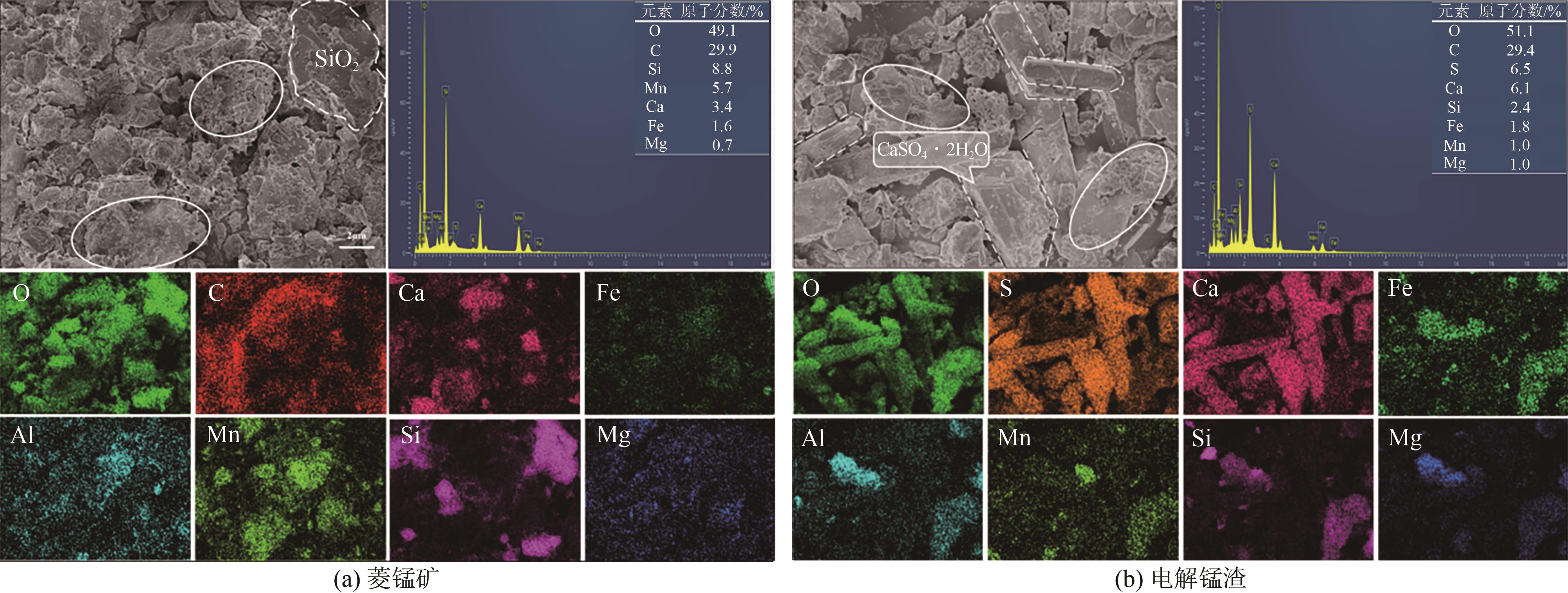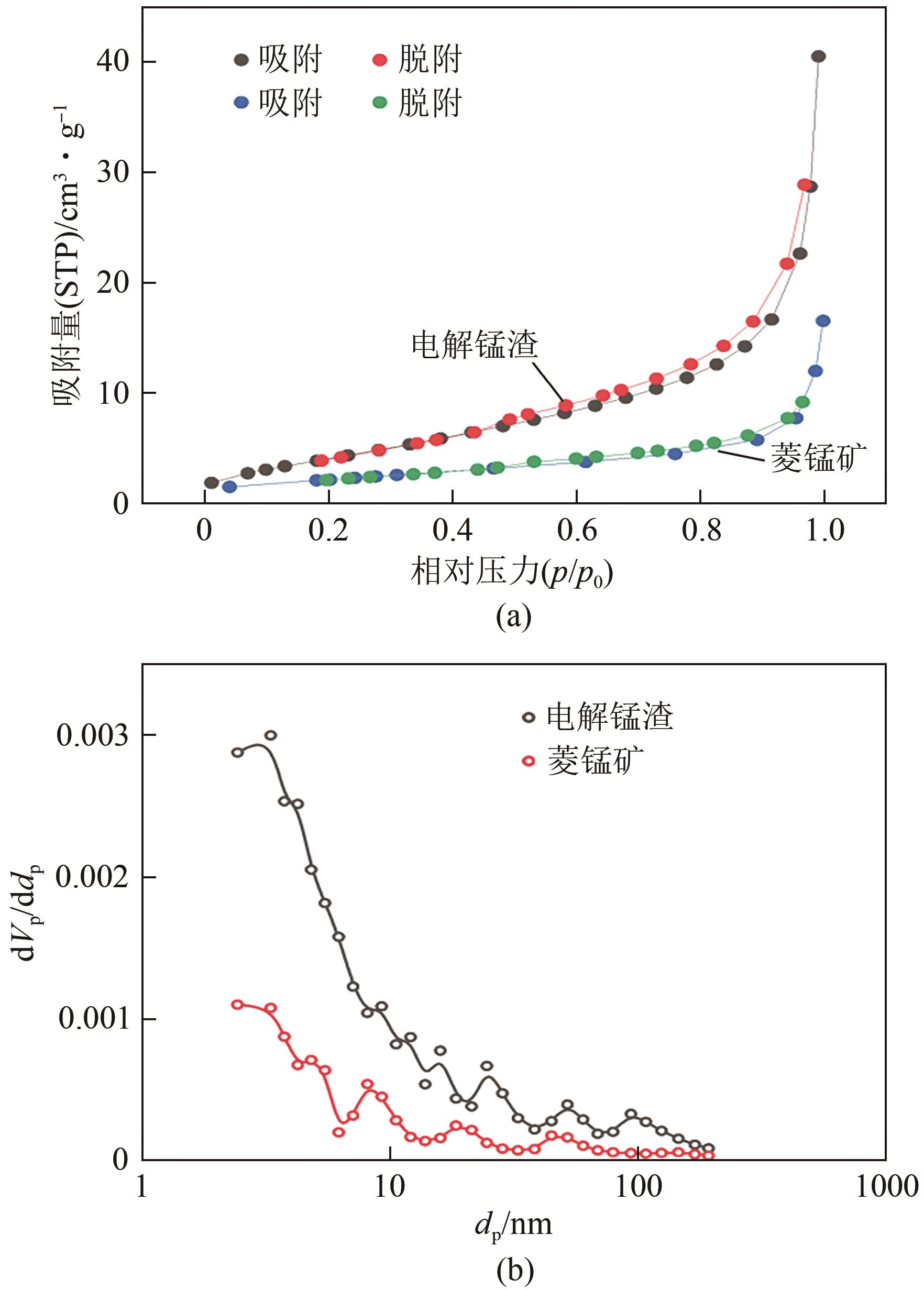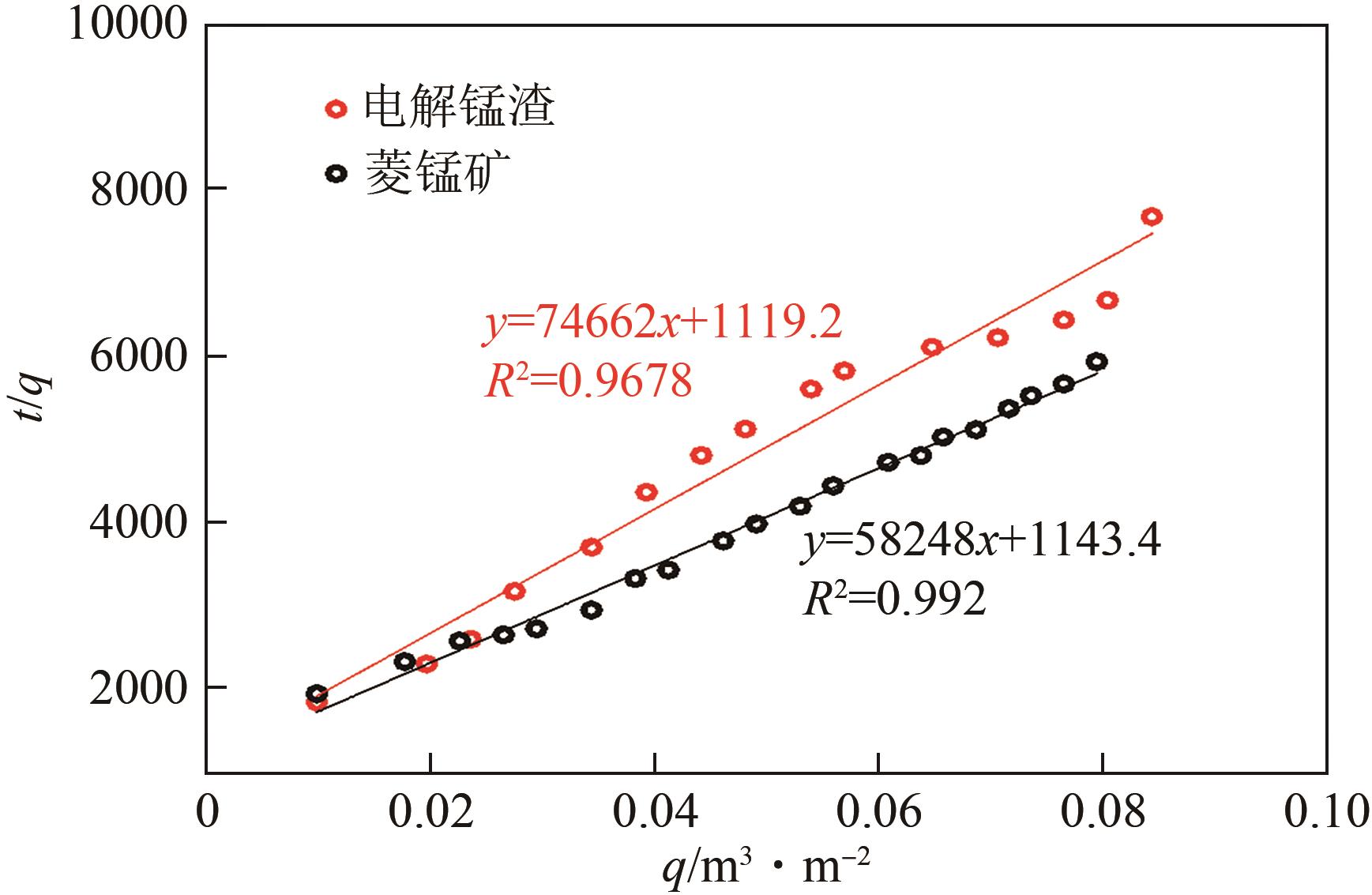Chemical Industry and Engineering Progress ›› 2024, Vol. 43 ›› Issue (9): 5320-5328.DOI: 10.16085/j.issn.1000-6613.2023-1429
• Resources and environmental engineering • Previous Articles Next Articles
Physicochemical properties of rhodochrosite before and after leaching and the changing law of interface hydration behavior
LI Zihan( ), SHU Jiancheng(
), SHU Jiancheng( ), CAO Wenxing, YANG Huimin, CHEN Mengjun
), CAO Wenxing, YANG Huimin, CHEN Mengjun
- School of Environment and Resource, Southwest University of Science and Technology, Mianyang 621000, Sichuan, China
-
Received:2023-08-16Revised:2024-03-06Online:2024-10-08Published:2024-09-15 -
Contact:SHU Jiancheng
菱锰矿浸出前后理化特性及界面水化行为变化规律
- 西南科技大学环境与资源学院,四川 绵阳 621000
-
通讯作者:舒建成 -
作者简介:李子寒(1999—),女,硕士研究生,研究方向为电解锰渣污染治理。E-mail:cdlizihan@163.com。 -
基金资助:国家自然科学基金(5217041232)
CLC Number:
Cite this article
LI Zihan, SHU Jiancheng, CAO Wenxing, YANG Huimin, CHEN Mengjun. Physicochemical properties of rhodochrosite before and after leaching and the changing law of interface hydration behavior[J]. Chemical Industry and Engineering Progress, 2024, 43(9): 5320-5328.
李子寒, 舒建成, 曹文星, 杨慧敏, 陈梦君. 菱锰矿浸出前后理化特性及界面水化行为变化规律[J]. 化工进展, 2024, 43(9): 5320-5328.
share this article
Add to citation manager EndNote|Ris|BibTeX
URL: https://hgjz.cip.com.cn/EN/10.16085/j.issn.1000-6613.2023-1429
| 样品 | 成分质量分数/% | |||||||
|---|---|---|---|---|---|---|---|---|
| SiO2 | MnO | CaO | Fe2O3 | Al2O3 | MgO | SO3 | 其他 | |
| 菱锰矿 | 33.46 | 30.53 | 15.68 | 10.77 | 3.44 | 2.85 | 0.94 | 2.33 |
| 电解锰渣 | 23.32 | 8.14 | 20.90 | 11.87 | 2.42 | 1.43 | 30.57 | 1.35 |
| 样品 | 成分质量分数/% | |||||||
|---|---|---|---|---|---|---|---|---|
| SiO2 | MnO | CaO | Fe2O3 | Al2O3 | MgO | SO3 | 其他 | |
| 菱锰矿 | 33.46 | 30.53 | 15.68 | 10.77 | 3.44 | 2.85 | 0.94 | 2.33 |
| 电解锰渣 | 23.32 | 8.14 | 20.90 | 11.87 | 2.42 | 1.43 | 30.57 | 1.35 |
| 参数 | 浸出前 | 浸出后 |
|---|---|---|
| 平均孔径/nm | 10.165 | 14.328 |
| 比表面积/m2∙g-1 | 8.20 | 17.06 |
| 孔容/cm2·g-1 | 1.88 | 3.92 |
| 参数 | 浸出前 | 浸出后 |
|---|---|---|
| 平均孔径/nm | 10.165 | 14.328 |
| 比表面积/m2∙g-1 | 8.20 | 17.06 |
| 孔容/cm2·g-1 | 1.88 | 3.92 |
| 参数 | 浸出前 | 浸出后 |
|---|---|---|
| 亲水系数 | 1.117 | 2.233 |
| 含水率/% | 17.68 | 32.67 |
| 润湿热/J·g-1 | 0.743 | 3.879 |
| 恒压过滤常数K | 1.72×10-5 | 1.34×10-5 |
| 过滤速率/mL·min-1 | 10.318 | 5.296 |
| 滤饼比阻/m·kg-1 | 2.00×107 | 4.86×107 |
| 参数 | 浸出前 | 浸出后 |
|---|---|---|
| 亲水系数 | 1.117 | 2.233 |
| 含水率/% | 17.68 | 32.67 |
| 润湿热/J·g-1 | 0.743 | 3.879 |
| 恒压过滤常数K | 1.72×10-5 | 1.34×10-5 |
| 过滤速率/mL·min-1 | 10.318 | 5.296 |
| 滤饼比阻/m·kg-1 | 2.00×107 | 4.86×107 |
| 1 | 谭柱中, 张丽云. 中国电解金属锰工业研究进展[J]. 中国锰业, 2019, 37(2): 1-2. |
| TAN Zhuzhong, ZHANG Liyun. A research progress in electrolytic manganese metal industry of China[J]. China Manganese Industry, 2019, 37(2): 1-2. | |
| 2 | 何德军, 舒建成, 陈梦君, 等. 电解锰渣建材资源化研究现状与展望[J]. 化工进展, 2020, 39(10): 4227-4237. |
| HE Dejun, SHU Jiancheng, CHEN Mengjun, et al. Current status and future prospects of electrolytic manganese residue reused as building materials[J]. Chemical Industry and Engineering Progress, 2020, 39(10): 4227-4237. | |
| 3 | 徐欢, 张超, 秦林, 等. 碳酸锰矿选矿技术研究进展与展望[J]. 中国锰业, 2023, 41(2): 1-6, 12. |
| XU Huan, ZHANG Chao, QIN Lin, et al. A research progress and prospects of manganese carbonate ore beneficiation technology[J]. China Manganese Industry, 2023, 41(2): 1-6, 12. | |
| 4 | DUAN Ning, DAN Zhigang, WANG Fan, et al. Electrolytic manganese metal industry experience based China’s new model for cleaner production promotion[J]. Journal of Cleaner Production, 2011, 19(17/18): 2082-2087. |
| 5 | 严超, 杨勇, 陈发明, 等. 电解锰渣无害化及资源化利用研究进展[J]. 中国锰业, 2023, 41(3): 4-9. |
| YAN Chao, YANG Yong, CHEN Faming, et al. Harmless treatment and resourceful utilization of electrolytic manganese residue: A review[J]. China’s Manganese Industry, 2023, 41(3): 4-9. | |
| 6 | 杨创, 张覃, 李龙江, 等. 贵州某低品位碳酸锰矿选矿提锰研究[J]. 有色金属(选矿部分), 2020, (3): 58-66. |
| YANG Chuang, ZHANG Qin, LI Longjiang, et al. Study on the separation of manganese from a low-grade manganese carbonate ore in Guizhou[J]. Nonferrous Metals (Mineral Processing Section), 2020, (3): 58-66. | |
| 7 | 蒙正炎, 高遇事, 贾韶辉, 等. 电解锰渣综合治理技术研究应用现状和思考[J]. 中国锰业, 2022, 40(2): 1-5. |
| MENG Zhengyan, GAO Yushi, JIA Shaohui, et al. A research and application on electrolytic manganese residue comprehensive treatment technique[J]. China Manganese Industry. 2022, 40(2): 1-5. | |
| 8 | LIU Chunfu, MIN Fanfei, LIU Lingyun, et al. Hydration properties of alkali and alkaline earth metal ions in aqueous solution: A molecular dynamics study [J]. Chemical Physics Letters, 2019, 727: 31-37. |
| 9 | 王彦, 李艳军. 某菱锰矿石工艺矿物学研究[J]. 金属矿山, 2019, (2): 188-191. |
| WANG Yan, LI Yanjun. Research on process mineralogy of a carbonaceous rhodochrosite ore[J]. Metal Mine, 2019, (2): 188-191. | |
| 10 | 李佳, 焦向科, 杜冬云, 等. 广西某电解锰渣的矿物学性质研究[J]. 硅酸盐通报, 2017, 36(3): 947-952. |
| LI Jia, JIAO Xiangke, DU Dongyun, et al. Mineralogical properties of electrolytic manganese slag from Guangxi[J]. Bulletin of the Chinese Ceramic Society, 2017, 36(3): 947-952. | |
| 11 | 李剑波. 煤泥水中微细粒矿物表面水化作用特性研究[D]. 太原: 太原理工大学, 2020. |
| LI Jianbo. Study on surface hydration characteristics of fine-particles in coal slime water[D]. Taiyuan: Taiyuan University of Technology, 2020. | |
| 12 | 王积伟. 电解锰渣无害化处理技术研究与应用[D]. 青岛: 青岛大学, 2012. |
| WANG Jiwei. Research and application of harmless treatment technology of electrolytic manganese slag[D]. Qingdao: Qingdao University, 2012. | |
| 13 | NING Duan, WANG Fan, ZHOU Changbo, et al. Analysis of pollution materials generated from electrolytic manganese industries in China[J]. Resources, Conservation and Recycling, 2010, 54(8): 506-511. |
| 14 | 朱唯, 陈远光, 许英鹏, 等. 酸浸锰矿及其尾渣的分析与表征[J]. 盐科学与化工, 2020, 49(3): 17-19. |
| ZHU Wei, CHEN Yuanguang, XU Yingpeng, et al. Analysis and characterization of acid leaching manganese ore and its tailings[J]. Journal of Salt Science and Chemical Industry, 2020, 49(3): 17-19. | |
| 15 | 黎广荣, 周义朋, 赵凯, 等. 砂岩型铀矿浸出矿物工艺学研究进展[J]. 有色金属(冶炼部分), 2021, (8): 9-19. |
| LI Guangrong, ZHOU Yipeng, ZHAO Kai, et al. Research progress on mineral leaching technology of sandstone type uranium deposits[J]. Nonferrous Metals (Extractive Metallurgy), 2021, (8): 9-19. | |
| 16 | 付勇, 魏帅超, 金若时, 等. 我国砂岩型铀矿分带特征研究现状及存在问题[J]. 地质学报, 2016, 90(12): 3519-3544. |
| FU Yong, WEI Shuaichao, JIN Ruoshi, et al. Current status and existing problems of China’s sandstone-type uranium deposits[J]. Acta Geologica Sinica, 2016, 90(12): 3519-3544. | |
| 17 | 魏文文, 黄思静, 郇金来. 伊利石形成相关反应的热力学计算及其对砂岩成岩作用研究的意义[J]. 地质科技情报, 2011, 30(1): 20-25. |
| WEI Wenwen, HUANG Sijin, HUAN Jinlai. Thermodynamic calculation of illite formation and its significance on research of sandstone diagenesis[J]. Geological Science and Technology Information, 2011, 30(1): 20-25. | |
| 18 | 朱平, 黄思静, 李德敏, 等. 黏土矿物绿泥石对碎屑储集岩孔隙的保护[J]. 成都理工大学学报(自然科学版), 2004, 31(2): 153-156. |
| ZHU Ping, HUANG Sijin, LI Demin, Liu Yuanchao, et al. Effect and protection of chlorite on clastic reservoir rocks[J]. Journal of Chengdu University of Technology (Science & Technology Edition), 2004, 31(2): 153-156. | |
| 19 | 杨峰, 宁正福, 张世栋, 等. 基于氮气吸附实验的页岩孔隙结构表征[J]. 天然气工业, 2013, 33(4): 135-140. |
| YANG Feng, NING Zhengfu, ZHANG Shidong, et al. Characterization of pore structures in shales through nitrogen adsorption experiment[J]. Natural Gas Industry, 2013, 33(4): 135-140. | |
| 20 | 邓亚玲, 舒建成, 陈梦君, 等. 不同堆存时间电解锰渣的理化特性分析[J]. 化工进展, 2022, 41(4): 2161-2170. |
| DENG Yaling, SHU Jiancheng, CHEN Mengjun, et al. Physical and chemical properties analysis of electrolytic manganese residue in different storage times[J]. Chemical Industry and Engineering Progress, 2022, 41(4): 2161-2170. | |
| 21 | 陈天虎, 徐惠芳, 彭书传, 等. 凹凸棒石与酸反应纳米尺度研究——反应机理和表面积变化[J]. 高校地质学报, 2004, 10 (1): 98-105. |
| CHEN Tianhu, XU Huifang, PENG Shuchuan, et al. Nanometer scale study on reaction of palygorskite with acid: Reaction mechanism and change of specific surface area[J]. Geological Journal of China Universities, 2004, 10(1): 98-105. | |
| 22 | CHEN Yuangan, FENG Bo, YAN Huashan, et al. Adsorption and depression mechanism of an eco-friendly depressant dextrin onto fluorite and calcite for the efficiency flotation separation[J]. Colloids and Surfaces A: Physicochemical and Engineering Aspects, 2022, 635: 127987. |
| 23 | MAJID Abdul, AHMAD Naeem, RIZWAN Muhammad, et al. Effects of Mn ion implantation on XPS spectroscopy of GaN thin films[J]. Journal of Electronic Materials, 2018, 47(2): 1555-1559. |
| 24 | 曾祥菲, 舒建成, 王继钦, 等. 超声波强化菱锰矿中锰的浸出[J]. 有色金属(冶炼部分), 2022, (2): 8-15. |
| ZENG Xiangfei, SHU Jiancheng, WANG Jiqin, et al. Ultrasonic-assisted leaching of manganese from rhodochrosite[J]. Nonferrous Metals (Extractive Metallurgy), 2022, (2): 8-15. | |
| 25 | 杜谷, 王坤阳, 冉敬, 等. 红外光谱/扫描电镜等现代大型仪器岩石矿物鉴定技术及其应用[J]. 岩矿测试, 2014, 33(5): 625-633. |
| DU Gu, WANG Kunyang, RAN Jing, et al. Application of IR/SEM and other modern instruments for mineral identification[J]. Rock and Mineral Analysis, 2014, 33(5): 625-633. | |
| 26 | 杨泽钰. 方解石结构矿物在高温下的稳定性研究[D]. 北京: 中国地质大学, 2021. |
| YANG Zeyu. Studies on stability of calcite structural mineralsunder high temperature[D]. Beijing: China University of Geosciences, 2021. | |
| 27 | 范晨子, 张誉, 陈郑辉, 等. 江西赣南风化淋滤型稀土矿床中的黏土矿物研究[J]. 岩石矿物学杂志, 2015, 34(6): 803-810. |
| FAN Chenzi, ZHANG Yu, CHEN Zhenghui, et al. The study of clay minerals from weathered crust rare earth ores in southern Jiangxi Province[J]. Acta Petrologica et Mineralogica, 2015, 34(6): 803-810. | |
| 28 | 武素茹, 宋义, 谷松海, 等. X射线荧光光谱-X射线衍射-红外光谱联用技术鉴别锰矿与锰冶炼渣[J]. 岩矿测试, 2015, 34(6): 659-664. |
| WU Suru, SONG Yi, GU Songhai, et al. Identification of manganese ore and manganese smelting slag by X-ray fluorescence spectrometry, X-ray diffraction and Fourier transform infrared spectroscopy[J]. Rock and Mineral Analysis, 2015, 34(6): 659-664. | |
| 29 | 虞祥, 邱志惠, 阮青锋, 等. 内蒙赤峰鱼眼石矿物学特征及其水的赋存状态研究[J]. 矿物岩石, 2021, 41(1): 15-24. |
| YU Xiang, QIU Zhihui, RUAN Qingfeng, et al. Mineralogical characteristics and water occurrence of apophyllite from Chifeng, inner Mongolia[J]. Mineralogy and Petrology, 2021, 41(1): 15-24. | |
| 30 | 刘迎新, 秦善, 刘瑞 等. 孔道结构矿物及其晶体结构特征[J]. 北京大学学报(自然科学版), 2004, 40(6): 993-1000. |
| LIU Yingxin, QIN Shan, LIU Rui, et al. Classification and framework features of tunnel structure minerals[J]. Acta Scientiarum Naturalium Universitatis Pekinensis, 2004, 40(6): 993-1000. |
| [1] | YIN Junquan, WU Yinkai, LI Weihua, SUN Yingjie, ZHANG Wenxuan, ZHANG Qingjian, MA Xiaoteng, BIAN Rongxing, WANG Huawei. Physicochemical characteristics and environmental risk of ash/slag in typical sections of MSW incineration [J]. Chemical Industry and Engineering Progress, 2024, 43(8): 4714-4725. |
| [2] | YU Zhengwei, ZHANG Xiaoxia, LEI Jie, LI Ao, WANG Guangying, DING Xiang, LONG Hongming. Comprehensive recovery of cerium and manganese from waste CeO x -MnO x -based SCR denitrification catalysts by reductive acid leaching [J]. Chemical Industry and Engineering Progress, 2022, 41(9): 5122-5131. |
| [3] | ZENG Yifan, SHU Jiancheng, YANG Huimin, ZHAO Zhisheng, CHEN Mengjun, YANG Yong, LIU Renlong. Transformation law of gypsum from electrolytic manganese residue in ammonium salt system [J]. Chemical Industry and Engineering Progress, 2022, 41(9): 5115-5121. |
| [4] | DENG Yaling, SHU Jiancheng, CHEN Mengjun, LEI Tianya, ZENG Xiangfei, YANG Yong, LIU Zuohua. Physical and chemical properties analysis of electrolytic manganese residue in different storage times [J]. Chemical Industry and Engineering Progress, 2022, 41(4): 2161-2170. |
| [5] | NIE Zimeng, YANG Dian, XIONG Yulu, LI Yingjie, TIAN Senlin, NING Ping. Performance and mechanism of electrolytic manganese slag slurry for flue gas desulfurization [J]. Chemical Industry and Engineering Progress, 2022, 41(2): 1063-1072. |
| [6] | CHEN Guodong, LIU Haicheng, MENG Wushuang, YOU Yu, ZHANG Hao, CAO Mengru. Research progress on artificial intervention and characterization of physicochemical properties of microplastics aging [J]. Chemical Industry and Engineering Progress, 2022, 41(12): 6443-6453. |
| [7] | JI Feng, ZHENG Bowen, LUO Ruoyin, DU Wei, DENG Chengwei, YANG Sheng, LIU Zhiqiang. Analysis and optimization of a HT-PEMFC stack [J]. Chemical Industry and Engineering Progress, 2022, 41(10): 5325-5331. |
| [8] | LI Haolin, ZENG Dehui, ZHENG Guangya, XIA Jupei. Extraction of aluminum and iron from coal gangue by low temperature neutralization-pressure acid leaching [J]. Chemical Industry and Engineering Progress, 2021, 40(7): 4011-4020. |
| [9] | MA Zhibin, ZHANG Xueli, GUO Yanxia, CHENG Fangqin. Research progress on characteristics and element dissolution behaviors of circulating gluidized bed-derived fly ash [J]. Chemical Industry and Engineering Progress, 2021, 40(6): 3058-3071. |
| [10] | Huiyao WANG, Yonggang WEI, Shiwei ZHOU, Bo LI, Yu SHI. Extraction of nickel and cobalt by microwave pretreatment-acid leaching of limonite high manganese laterite ore [J]. Chemical Industry and Engineering Progress, 2020, 39(5): 1907-1914. |
| [11] | Dejun HE, Jiancheng SHU, Mengjun CHEN, Jianyi WANG, Yushi GAO, Ning WANG, Hannian GU. Current status and future prospects of electrolytic manganese residue reused as building materials [J]. Chemical Industry and Engineering Progress, 2020, 39(10): 4227-4237. |
| [12] | Xuexiang FU, Dengfeng ZHANG, Wenping JIANG, Zengmin LUN, Chunpeng ZHAO, Haitao WANG, Yanhong LI. Influence of physicochemical properties of coals on pore morphology and methane adsorption: a perspective [J]. Chemical Industry and Engineering Progress, 2019, 38(06): 2714-2725. |
| [13] | Meixue JIANG, Hongjuan SUN, Tongjiang PENG. Extraction of iron oxide from titanium gypsum by sulfuric acid leaching and phase transform of gypsum [J]. Chemical Industry and Engineering Progress, 2019, 38(04): 2030-2036. |
| [14] | Baojun YANG,Xiaoyu FANG,Bainian WANG,Yinzhe DONG,Mengmeng YANG. Extraction of iron from pyrite cinder via oxalic acid-intensified leaching method [J]. Chemical Industry and Engineering Progress, 2019, 38(03): 1552-1560. |
| [15] | DENG Jun, ZHU Xuejun, ZHANG Yi. Experimental study on extracting titanium from high titanium slag recovery dust leached in hydrochloric acid assisted by ultrasonic wave [J]. Chemical Industry and Engineering Progree, 2016, 35(S2): 376-380. |
| Viewed | ||||||
|
Full text |
|
|||||
|
Abstract |
|
|||||






